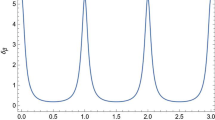Abstract
We study the locally conformal invariant Weyl theory of gravitation and introduce a conformally coupled scalar field. Einstein gravity is induced by spontaneous breaking of the local conformal symmetry in an effective long range approximation. The effective potential for the scalar field is calculated at the one-loop level up to curvature squared in order in an arbitrary curved background. The non-zero vacuum expectation value of the scalar field induces the dimensional Einstein's gravitational coupling constant stably in case ofR > 0. ForR < 0, the phase transition occurs from the symmetric phase to the broken phase as the curvature decreases. This theory may be an attractive candidate for the primordial inflationary universe scenario.
Similar content being viewed by others
References
Utiyama, R. and DeWitt, B. S. (1962).J. Math. Phys.,3, 608.
Stelle, K. S. (1977).Phys. Rev. D,16, 953.
Adler, S. L. (1982).Rev. Mod. Phys.,54, 729.
Schwarz, J. H., ed.Superstring, (2 vols., World Scientific, Singapore).
Weyl, H. (1918).Sitzungsber. Preuss. Akad. Wiss., 465.
van Nieuwenhuizen, P. (1981).Phys. Rep.,68, 189.
Fradkin, E. S., and Tseytlin, A. A. (1985).Phys. Rep.,119, 233.
Fujii, Y. (1974).Phys. Rev. D,9, 874.
Deser, S. (1970).Ann. Phys.,59, 248.
Julve, J., and Tonin, M. (1978).Nuovo Cimento,46B, 137.
Fradkin, E. S., and Tseytlin, A. A. (1981).Phys. Lett.,104B, 377; (1982).Nucl Phys.,B201, 469.
Avramidi, I. G. (1986).Sov. J. Nucl. Phys.,44(1), 160.
Grisaru, M. T., and Siegel, W. (1982).Nucl. Phys.,B201, 292.
Howe, P. S., Stelle, K. S., and Townsend, P. K. (1984).Nucl. Phys.,B236, 125.
Fradkin, E. S., and Tseytlin, A. A. (1982).Nucl. Phys.,B203, 157.
Fradkin, E. S., and Tseytlin, A. A. (1982).Phys. Lett.,110B, 117 (and Errata (1983)126B 506).
Duff, M. J. (1977).Nucl. Phys.,B125, 334.
Fradkin, E. S., and Tseytlin, A. A. (1984).Phys. Lett,134B, 187.
Boulware, D. G. (1984). InQuantum Theory of Gravity, S. M. Christensen, ed. (Adam Hilger, Bristol).
Boulware, D. G., Horowitz, G. T., and Strominger, A. (1983).Phys. Rev. Lett,50, 1726.
Kaku, M. (1983).Phys. Rev. D,27, 2809.
Kaku, M. (1983).Phys. Rev. D,27, 2819.
Tomboulis, E. T. (1984).Phys. Rev. Lett.,52, 1173.
Tomboulis, E. T. (1977).Phys. Lett.,70B, 361.
Tomboulis, E. T. (1980).Phys. Lett,97B, 77.
Tomboulis, E. T. (1984). InQuantum Theory of Gravity, S. M. Christensen, ed. (Adam Hilger, Bristol).
Strominger, A. (1984). InQuantum Theory of Gravity, S. M. Christensen, ed. (Adam Hilger, Bristol).
Antoniadis, I., and Tsamis, N. C. (1984). Preprint SLAC-PUB-3297.
Kugo, T., and Uehara, S. (1983).Nucl. Phys.,B226, 49.
Brans, C., and Dicke, R. H. (1961).Pkys. Rev.,124, 925.
Bergshoeff, E., de Roo, M., and de Wit, B. (1983).Nucl. Phys.,B217, 489.
de Roo, M. (1985).Nucl. Phys.,B255, 515.
de Roo, M., and Wagemans, P. (1985).Nucl. Phys.,B262, 644.
Coleman, S., and Weinberg, E. (1973).Phys. Rev. D,7, 1888.
Abbot, L. F. (1981).Nucl. Phys.,B185, 189.
't Hooft, G. (1971).Nucl. Phys.,B33, 173.
Barth, N. H. and Christensen, S. M. (1983).Phys. Rev. D,28, 1876.
Fradkin, E. S., and Vilkovisky, G. A. (1978).Phys. Lett.,73B, 209.
Ishikawa, K. (1983).Phys. Rev. D,28, 2445.
DeWitt, B. S. (1965).Dynamical Theory of Groups and Fields, (Gordon and Breach, New York).
Barvinsky, A. O., and Vilkovisky, G. A. (1985).Phys. Rep.,119, 1.
Author information
Authors and Affiliations
Rights and permissions
About this article
Cite this article
Matsuo, N. Einstein gravity as spontaneously broken Weyl gravity. Gen Relat Gravit 22, 561–593 (1990). https://doi.org/10.1007/BF00756230
Received:
Issue Date:
DOI: https://doi.org/10.1007/BF00756230



